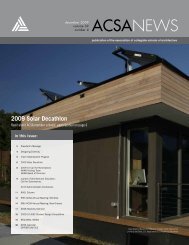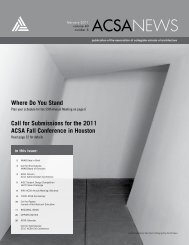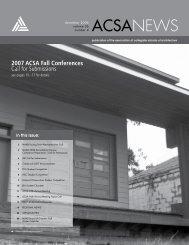digital aptitudes - Association of Collegiate Schools of Architecture
digital aptitudes - Association of Collegiate Schools of Architecture
digital aptitudes - Association of Collegiate Schools of Architecture
Create successful ePaper yourself
Turn your PDF publications into a flip-book with our unique Google optimized e-Paper software.
SATURDAY, MARCH 3, 2012 - 10:30AM - 12:00PM<br />
Digital Details<br />
Matt Burgermaster, New Jersey Institute <strong>of</strong> Technology<br />
Optimization Takes Command: Miscalculations in<br />
Performative Design<br />
Doris Kim Sung, University <strong>of</strong> Southern California<br />
As the natural in nature gradually disappears, research’s obsession<br />
with simulating, replicating, deviating, and mutating nature as<br />
means to control the extinction <strong>of</strong> that same organic world around<br />
us, ironically increases the realm <strong>of</strong> artificiality and, ultimately, the<br />
dependency on math, sciences and technology. Design research is<br />
no exception, where the notions <strong>of</strong> optimization are derived from<br />
the self-perpetrating obsessions with math and science, reliance on<br />
algebraic or logarithmic equations for geometry generation, and<br />
the dependence on the logic <strong>of</strong> the physics <strong>of</strong> nature for identification<br />
<strong>of</strong> the lowest energy states. This same pursuit <strong>of</strong> optimization<br />
has pr<strong>of</strong>oundly influenced decision-making in the design process.<br />
In many cases, efficient use <strong>of</strong> materials, effective selection <strong>of</strong> design/construction<br />
strategies, lower energy use and minimal waste<br />
have affected the choices that are made from schematic design<br />
to construction, and add to the traditional pressures <strong>of</strong> cost effectiveness<br />
and densification <strong>of</strong> planametric space. Engineers have<br />
become integral players <strong>of</strong> schematic design teams, playing larger<br />
roles in the integration <strong>of</strong> structural and M/E/P systems in order<br />
to prevent unnecessary redundancy throughout. Additionally,<br />
newly available and powerful computer s<strong>of</strong>tware makes the realization<br />
<strong>of</strong> optimization <strong>of</strong> complex shapes, fluid parameterization,<br />
unimaginable forms and material feasible. Never before have we<br />
been able to make, test and fabricate parts <strong>of</strong> architecture as we<br />
can today. As a result, projects have become more ambitious, resulting<br />
in forms and tectonics that are complex, multi-faceted and<br />
comprehensive with a definitive effect on the aesthetic outcome<br />
<strong>of</strong> a project and an indelible change on the new landscape <strong>of</strong> man.<br />
These projects have historically been limited to static systems.<br />
Now, add dynamic input systems into this equation. Because realistically<br />
architecture must respond and mediate between multiple<br />
non-stationary variables, it is clear that the response <strong>of</strong> the<br />
architecture must also be dynamic and fluid from the large scale<br />
(programmatically) to the very small (nanomaterials). But, to understand<br />
the meaning <strong>of</strong> optimization vis-a-vis performance criteria<br />
in dynamic models, holistic understanding <strong>of</strong> the input, output<br />
and deviations must be considered. This paper will present projects<br />
completed by the author made <strong>of</strong> thermobimetals, where the<br />
consequences <strong>of</strong> sheer science resolution and idiosyncratic inconsistencies<br />
from logic, lead to an aesthetic <strong>of</strong> optimization, responsiveness<br />
and performance <strong>of</strong> dynamic systems, namely in the use<br />
or misuse <strong>of</strong> incomplete <strong>digital</strong> tools (scripting, programs, etc.),<br />
true understanding <strong>of</strong> fabrication tools and assembly limitations,<br />
irregular insertion <strong>of</strong> overlapping mobile components (material behavior),<br />
and wavering definition <strong>of</strong> criteria in structural systems.<br />
Although “form, structure, and material act upon each other, and<br />
this behavior <strong>of</strong> all three cannot be predicted by analysis <strong>of</strong> any<br />
one <strong>of</strong> them separately” (Weinstock, 2010), for purpose <strong>of</strong> discussion,<br />
each will be identified in its own section, but, by no means,<br />
should be considered in isolation from its intertwined context.<br />
Tending to the Detail<br />
Patrick Doan, Virginia Tech<br />
In an ‘age <strong>of</strong> <strong>digital</strong> ubiquity’ it is important to not lose sight <strong>of</strong> the<br />
architectural details potency within the practice <strong>of</strong> architecture.<br />
The detail is not passive, disposable, a production drawing buried<br />
within the pages <strong>of</strong> a construction document set, or the product<br />
<strong>of</strong> a specific tool. Rather, it is the embodiment <strong>of</strong> the architect’s<br />
knowledge, skill, understanding, and sensitivity to how materials<br />
and spaces are thoughtfully formed and brought together. Born<br />
<strong>of</strong> the architect’s imagination, the detail is complex and multi-dimensional;<br />
operating simultaneously at multiple scales addressing<br />
constructive, formal, and spatial questions <strong>of</strong> joining. Tending to<br />
the detail is to turn our attention back to the role the architectural<br />
detail plays in the making and crafting <strong>of</strong> works <strong>of</strong> architecture.<br />
Digital Apptitutes + Other Openings - Boston, MA - 29








